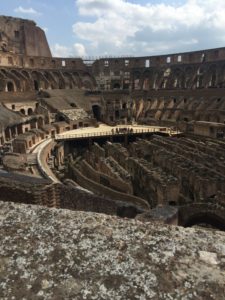-
Colosseum – Opened in 80 A.D., the site of many bloody gladiatorial fights, seating could then hold about 50,000 spectators. With a circumference of 573 yards and sitting on marshland, experts say the Colosseum is an engineering wonder… not to mention an animal—and human—rights atrocity. To avoid crowds, visit in late afternoon on a sunny day. Avoid weekends.
-
Roman Forum – This area comprises much of Ancient Rome’s most important structures, from shrines to government houses to monuments. Although much of the complex is in ruins, the remains allow one to imagine the former glory of structures such as the Arch of Septimius Severus, the Temple of Saturn, the Arch of Titus and the House of the Vestal Virgins, among others. Get in with a Colosseum ticket, best to see it first. Avoid this site on rainy days.
-
Trevi Fountain – The fountain was finished in the mid-1700s and is the powerful example of a baroque design with a distinctly mythological character. The Titan god of the sea, Oceanus emerges from the pool, flanked by his trusty Tritons. The fountain underwent an extensive restoration and reopened in its current splendor in November 2015. According to Roman tradition, throwing one coin into the Trevi with your right hand over your left shoulder ensures you’ll return to Rome; two coins means you’ll fall in love with an attractive Roman; three coins that you’ll marry that same Roman. Best time to have the fountain all to yourself is late at night or before 8 am each morning.
-
St. Peter’s Basilica – The epicenter of Roman Catholicism, the church is centered in Vatican City, open daily 7am to 7pm, and is free. It is closed on Wednesday mornings for pope appearances. My favorite time here is 7am, when there are no visitors!
-
Vatican Museum – Includes the Sistine Chapel and Michelangelo’s famous frescoes. The museum is so immense that guided tours seem the best, but most expensive, option. My favorite parts of the museum are the Raphael Rooms and the spiral staircase. To avoid crowds, skip weekends and Wednesdays. Best time to have the most art to yourself is after 2 pm. Ignore any unsolicited ticket offers that promise to cut the lines.
-
Pantheon – A former Roman temple and a present-day church, this structure is known for its perfect proportions, which is amazing, seeing as it was raised in A.D. 120. While you’re there, you can also pay your respects to Raphael, as well as Italian kings Victor Emmanuel II and Umberto I, who are all buried there. Best time to visit, ca. 6 pm in the evenings. From here, take a short walk to best known gelattorias in town)


-
The food. In Rome, meal is a cooking show, a celebration of life, and a huge social event. No one ever eats alone! Or quickly.
-
Breakfast treats: Cappuccino and pastries, from the bakery next door.
-
Lunch: A slice of pizza or panini sandwich, best if from a street vendor. (Many Romans line up for fresh pizza bianca from Il Forno at Camp Dei Fiori)
-
Dinner: Incredible pasta dishes at any small trattoria (these are family owned, neighborhood eateries with handwritten menus)
-
Any-time-of-the-day splurge: Gelato in a cup (or cone); there are over 150 flavors to chose from!
-
NOTE: My favorite places for snacking or tasty lunch are local farmer’s markets (I have counted at least 6 such markets in Rome; keep in mind that some of these markets can be very upscale, trendy centers)
-

-
The heart of the city: The open and farmer’s markets; the best one is at Campo Dei Fiori.
-
The lungs of the city: Rome is huge but walkable! Stop by one of many of parks to relax, to think, to socialize with locals, or to exercise. My favorite park is the Villa Borghese Gardens. Another experience that will make you feel like a local is when you join locals on daily passeggiata walks (from 6 pm) though many pedestrian-only streets of Rome.
-
The soul of the city: Rome boasts over 900 Catholic churches of all sizes and shapes (plus around 80 more Protestant, Anglican, and Orthodox places of worship). In addition to admiring the architecture of churches on literally most every corner of the city, when inside you can enjoy free, museum quality art of Michelangelo, Caravaggio, ancient mosaics, and Greek statues and monuments. My favorite artifact is “Sancta Scala” next to the St. John’s Lateran Church.
-
Special linger longer places: The Trevi Fountain in the early mornings and the Pantheon after sunset!
-
Special find: Rome is the home to 13 Egyptian obelisks; during the Roman Empire days, each stone marked a turning point for the chariot racing arenas (known as “circus”). Trekkers through the city enjoy the challenge of finding as many of those markers as they can. The most famous of those stones marks the site of Nero’s Circus (now St. Peter’s Square in Vatican), the site of the execution of apostle Peter according to church tradition.
-
The Eternal City: My favorite time to explore Rome is by night. After dark, you can have the Vatican City, Castle Sant’Angelo, or the Colosseum almost exclusively for yourself!


